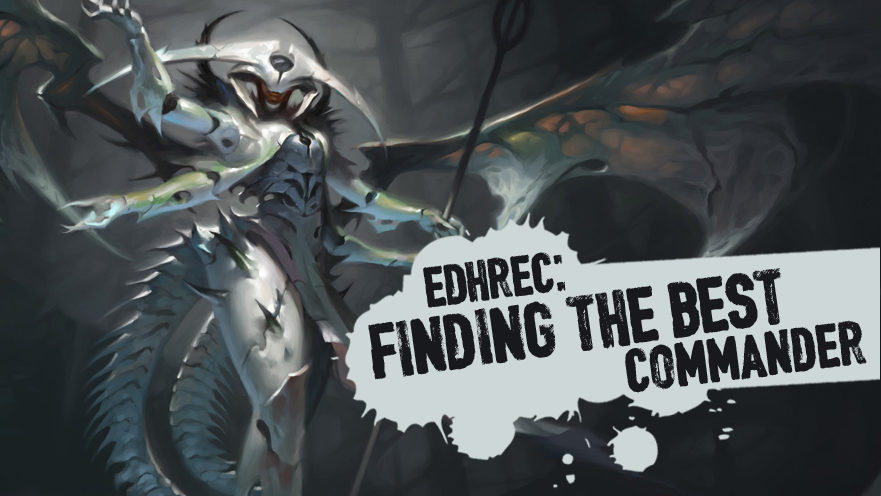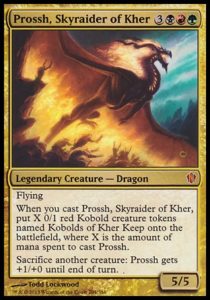A few weeks ago, Card Kingdom partnered with EDHREC, one of my favorite Magic: The Gathering sites. EDHREC is a crowdsourced repository of Commander decks and ideas – users submit decks, and EDHREC runs the numbers to tell you which cards are most popular in various lists. It’s a great resource for any Commander player, but I especially love it because it allows me to compare my wacky ideas with the average player’s. Today, I want to show you how useful EDHREC can be when you’re building or fine-tuning a Commander deck. We’ll be taking a look at sample lists that the site has generated for some popular Commanders, analyzing the trends, and trying to build the best decks we can.
ATTRACTED TO ATRAXA
With over 2,800 entries, Atraxa is by far the most popular Commander in the EDHREC database, and for good reason. This infecting, Planeswalker-ultimate-ing Voice of the Praetors provides five relevant abilities in a neat 4/4 package. Atraxa will shine in just about any deck, but how can we build the best home for her?
Interestingly, the majority of Atraxa players built their decks by editing store-bought copies of the Commander 2016 deck Breed Lethality, and they’ve made very few edits. If we cross-reference our sample with the precon, they’re 49% the same. (Note: I didn’t count basic lands, which would skew that percentage even higher.) That’s a high number, but not surprising. It’s easy to play this deck right out of the box, and the majority of players apparently came to the same conclusions I did: fix the mana, cut Orzhov Advokist (and other non-essentials), and add Doubling Season and as many Planeswalkers as possible. Boom. You’ve got a deck that’s easily playable.
As mentioned, the mana base was the only real knock against the precon. Having to take a turn off to cycle Migratory Route or Ancient Excavation just to fix mana presented some challenges, particularly for Atraxa and Yidris decks, which would prefer to be playing spells every turn. Fortunately, many EDHREC users have spruced up their decks with shocks and fetches – cards that most newer Magic players have in their collections thanks to recent reprints. While I appreciate that they’re willing to spend money on better mana, I’m a little disappointed that the average Atraxa player used only 36 lands. Perhaps playgroups are still making up their own mulligan rules, but anything less than 38 seems light to me.
Some more card-specific notes about the sample: There is only one card with infect on the list, Viral Drake, which appeared in over 700 lists. That’s high for a single card, but Drake makes sense as a backup plan, and if you want one source of infect, I think that’s the best choice. Obviously, Planeswalkers have significantly more casual appeal, but I still thought infect-focused builds would be more prominent. Using the Advanced Search feature, I found that Atraxa Infect only accounts for about 200 lists (approximately 7%) submitted to EDHREC. I did this by searching for cards like Viridian Corrupter, or Hand of the Praetors— cards that someone would only include in an Infect list.
If you’re looking to build Atraxa, the deck still seems “unsolved” by EDHREC’s user base. The Breed Lethality deck provides and strong and popular base, but if you’re looking to build a more entertaining version of this deck (e.g. play with Icatian Javalineers), you’ll have some serious research to do. If you’re looking for another sample Atraxa deck, here’s a casual, Planeswalker-heavy version that I put together.
PROSSH AND POWER OVER TIME
Prossh is another great Commander to examine, because the sample list on EDHREC has deviated so much from the original precon. The sample shows that Prossh wasn’t just seeing play because he was shiny and new – with access to a handful of combos that can end drawn-out games quickly, players have taken a liking to the Jund-colored dragon of Kher. These players have taken time to modify their Prossh lists and invest in powerful cards like Demonic Tutor and Food Chain. Worth noting: EDHREC wasn’t around when Prossh was first printed, so we’re likely to see a smaller sample of more focused lists.
I mentioned Food Chain earlier because it’s remarkably common in Prossh decks – 38% of over 1,300 lists play it. Food Chain is stronger here than Rooftop Storm is in a zombie deck, allowing the Prossh player to cast their Commander infinitely while generating infinite mana in the process. A combo like this is so enticing that Prossh players were willing to spend $40 to secure an old Mercadian Masques rare.
Food Chain isn’t the only expensive card here. The sample list contains Demonic and Vampric Tutor to help Prossh find game-enders like Craterhoof Behemoth or Purphoros, God of the Forge. This helps enable consistent attacks with Prossh while providing the flexibility to go combat-wide with tokens, go narrow with 21 Commander damage, or beat a tough board stall.
EDHREC’s sample Prossh deck also has a very solid mana base, which shows just how much the average casual Magic player is willing to spend. That said, the land selection could be better – I wouldn’t expect Bayous or Taigas, but I wouldn’t be surprised to see them, either. Theros-block scry lands were more what I was envisioning, plus Windswept Heath and Polluted Delta – the off-color fetches that competitive players will play for functionality, but that most casual players will avoid for aesthetic reasons.
This Prossh sample provides some useful data if you’re looking to make improvements to an existing deck. It’s evident that EDHREC’s community of players has spent time and energy refining this deck and narrowing it down to its two core competencies: casting Prossh, and smashing face. I took a stab at a Prossh deck of my own, which includes many of the pieces EDHREC recommended.
CONCLUSION
Many factors can determine what you see in the data on EDHREC, so it’s important to have a good grasp on how popularity and timing of certain affect the output. While you could always use EDHREC to net-deck, it’s much valuable as a data source – a place to learn more about the decks you want to build.
Header design: Justin Treadway
Header art: “Atraxa, Praetors’ Voice” by Victor Adame Minguez

For most of his Magic-playing life, Aaron has been playing and writing about Commander. One of the few mono-colored players in a gold-bordered world, Aaron enjoys the challenges of creating meaningful, memorable games, as well as the excitement that comes with engaging underrated cards as he explores the format’s uncharted territory. A disciplined deckbuilder with over 200 lists to his name, Aaron has spent the past several years creating content about his favorite format.



